![]()
![]()
![]()
Use LEFT and RIGHT arrow keys to navigate between flashcards;
Use UP and DOWN arrow keys to flip the card;
H to show hint;
A reads text to speech;
64 Cards in this Set
- Front
- Back
- 3rd side (hint)
|
Congenital heart disease CXR approach |
1.vascularity
|
|
|
|
Congenital heart disease
Acyanotic heart disease Increased pulmonary vascularity? |
(Left to Right Shunt) |
|
|
|
Congenital heart disease
Acyanotic heart disease Normal pulmonary vascularity? |
Aortic stenosis |
|
|
|
Congenital heart disease
Cyanotic heart disease? |
Normal or decreased pulmonary vascularity: |
|
|
|
Congenital heart disease
Increased pulmonary vascularity? |
the "5Ts:" |
|
|
|
Congenital heart disease
Pulmonary edema in newborns? |
Cardiac: |
|
|
|
Congenital heart disease
Massive cardiomegaly in the newborn? |
Box-shaped right heart (RA enlarged): |
|
|
|
Congenital heart disease
Boot-shaped heart? |
Tetralogy of Fallot |
|
|
|
Congenital heart disease with normal heart size and normal lungs?
|
Coarctation |
|
|
|
Congenital heart disease
Skeletal abnormalities and heart disease? |
- Rib notching: coarctation |
|
|
|
Congenital heart disease
Inferior rib notching? |
Aortic obstruction: |
|
|
|
Congenital heart disease
Superior rib notching? |
Abnormal osteoclastic activity: |
|
|
|
Aortic arch anomalies
|
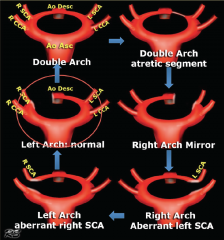
|
|
|
|
Most common types of complete vascular rings
|
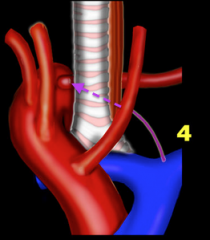
Two most common types of complete vascular rings (85–95%)
o Double aortic arch o Right aortic arch with left ligamentum arteriosum |
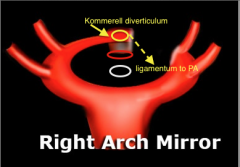
|
|
|
Right aortic arch and congenital heart disease?
|
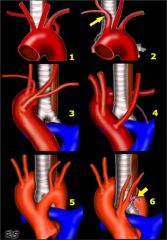
Truncus arteriosis (50%)
Tetralogy of Fallot (30%) Transposition of great arteries Tricuspid atresia Pulmonary atresia with VSD Double outlet right ventricle Pseudotruncus Asplenia Pink tetralogy |
|
|
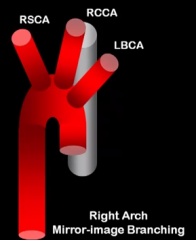
|
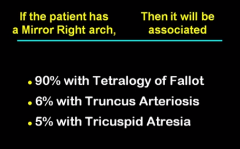
|
|
|
|
Acquired heart disease |
Pump failure: |
|
|
|
Acquired heart disease |
Normal variant (deep inspiration) |
|
|
|
Acquired heart disease
Left atrial enlargement? |
Mitral regurgitation (LA and LV enlarged) |
|
|
|
Acquired heart disease |
Thrombus |
|
|
|
Acquired heart disease |
Benign: |
|
|
|
Acquired heart disease
Pericardial effusion? |
CHF |
|
|
|
Acquired heart disease |
Severe anemia |
|
|
|
Acquired heart disease
CHF? |
High output failure by age: |
|
|
|
Cardiovascular calcifications
Pericardial? |
Pericarditis |
|
|
|
Cardiovascular calcifications
Myocardial? |
Coronary arteries |
|
|
|
Cardiovascular calcifications |
Calcified valves
Calcified thrombus Tumors |
|
|
|
Cardiovascular calcifications |
Atherosclerosis
Syphilitic aortitis Aneurysm |
|
|
|
Pneumopericardium?
|
Iatrogenic (aspiration, puncture) |
|
|
|
Coronary aneurysm?
|
Atherosclerotic |
|
|
|
Pulmonary artery enlargement?
|
Pulmonary artery HTN: |
|
|
|
Pulmonary arterial HTN
Classification? |
Pre-capillary
Post-capillary |
|
|
|
Pulmonary arterial HTN
Pre-capillary HTN? |
Left to right shunts
Chronic PE Vasculitis/ Connective tissue diseases Drugs Idiopathic Emphysema Schistosomiasis Interstitial fibrosis Fibrothorax, chest wall deformities Alveolar hypoventilation |
|
|
|
Pulmonary arterial HTN
Post-capillary HTN? |
LV failure |
|
|
|
Pulmonary venous HTN
|

LV dysfunction:
-Ischemic heart disease -Valvular heart disease -CHD -Cardiomyopathy Left atrium: -Cor triatriatum -LA myxoma PVOD Fibrosing Mediastinitis |
|
|
|
GROSS CARDIAC ENLARGEMENT
|
- Multiple valve disease (usually initially due to aortic or mitral valve disease, particularly regurgitation, which progresses to left and then right heart failure) |
|
|
|
Persistent arterial truncus |
(50% have a right arch) or tetralogy of Fallot |
|
|
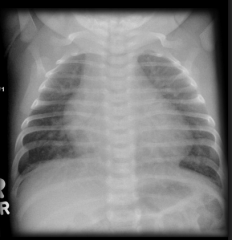
|
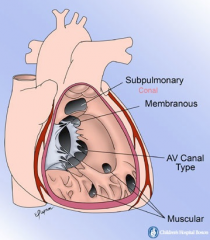
Associations with VSD
Part of Tetralogy of Fallot 50% of patients with a VSD have an associated additional cardiac abnormality - Coarctation of the aorta - Aortic stenosis - Tricuspid atresia |
Acianotic
|
|
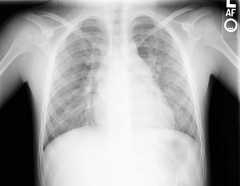
|

ASD |
|
|

|
TAPVC associations |
|
|
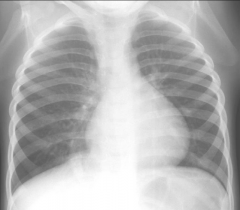
|
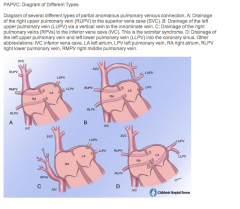
PAPVC associations |
|
|
|
Hypogenetic lung syndrome,
congenital pulmonary venolobar syndrome |
Scimitar syndrome triad:
Right lung hypoplasia, anomalous right pulmonary venous connection to inferior vena cava (IVC), and anomalous systemic arterial supply to right lower lobe |
|
|
|
Tetrology Variants
|
Pentalogy - TOF + ASD |
|
|
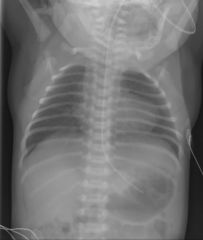
|
TOF associations: |
|
|
|
HYPOPLASTIC LEFT HEART
|
Spectrum of cardiac anomalies characterized by underdevelopment of LA, LV, MV, aortic valve, and aorta. |
|
|
|
Aortic root
|
-Valvular |
|
|
|
Polyarteritis nodosa, |
-Kussmaul disease - vasculitis of medium & small-sized arteries. -attack by rogue immune cells. -minority of people (about 30%) diagnosed have an active Hepatitis B infection, and men are also twice as likely to get the disease as women. |
|
|
|
Atrial situs
|

atrial appendages (best method)
Right atrial appendage is triangular with a wide base Left atrial appendage is a tubular structure |
|
|
|
Atrioventricular connection
|
Irrespective of atrioventricular concordance, the atrioventricular valve is |
|
|
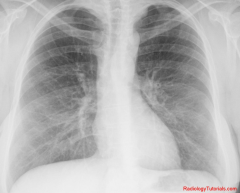
|
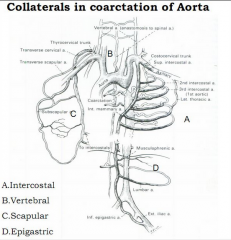
Coarctation
Turner's syndrome (20%) Berry aneurysms 5-10% Hypertension Bicuspid valve 75% VSD Fetal alcohol syndrome(mid aorta). Cystic medial necrosis of the aorta. Hypoplastic left heart syndrome |
|
|
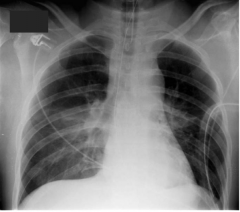
|
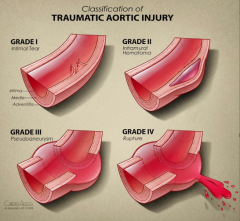
Traumatic aortic injury
|
|
|
|
Cardiac enhancement patterns |
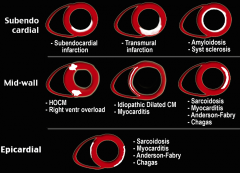
|
|
|
|
Cardiomyopathies |
Ischemic Cardiomyopathy |
|
|
|
DCM |
- Most common type - dilatation of all chambers (particularly LV) - present with CCF - Patients with midmyocardial enhancement are at higher risk of sudden cardiac death and arrhythmias - differentiation between idiopathic dilated cardiomyopathy and ischemic dilated cardiomyopathy is important (ENHANCEMENT PATTERN) |
|
|
|
HCM |
- idiopathic hypertrophic subaortic stenosis (IHSS) - VS acquired LVH and AS - sudden death - CMR - enhancement of basal septum |
|
|
|
RCM (compliance type) |
- Diminished compliance (=diastolic dysfunction) - idiopathic vs acquired (infiltration=restrictive pattern) - important to distinguish restrictive from constrictive cardiomyopathy |
|
|
|
RCM (volume) |
- mainly a disease of children - due to endomyocardial fibrosis (EMF) and Loeffler's endocarditis |
|
|
|
LVNC |
- rare form of congenital cardiomyopathy - emboli (40%) , low output failure - myocardium has a „spongy‟ appearance, trabeculated - associated with CHD vs. Isolated form |
|
|
|
ARVD |
- There are two variants of ARVC: fatty and fibro-fatty infiltration - found in the subtricuspid area, the right ventricular apex, and the infundibulum, the 'triangle of dysplasia' |
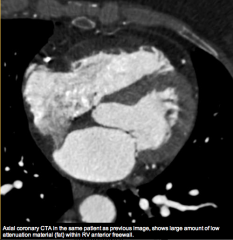
|
|
|
LESS COMMON „SPECIFIC‟ CAUSES OF CARDIOMYOPATHY |

|
|
|
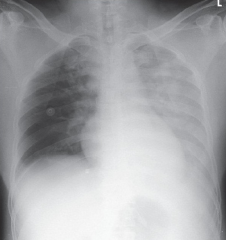
|
Unilateral pulm oedema |

|
|
|
Acute aortic syndrome approach |
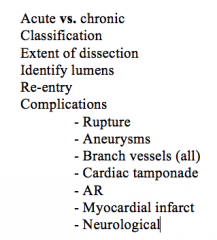
|

|
|
|
Takayasu Classification |

|
|
|
|
AAA |

Cx - |
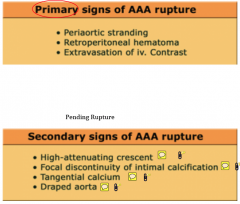
|

